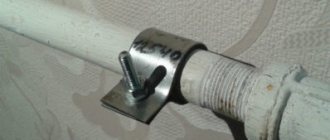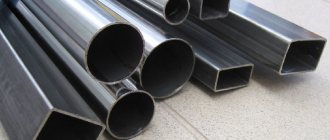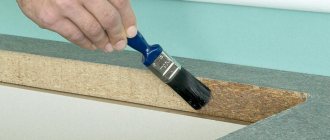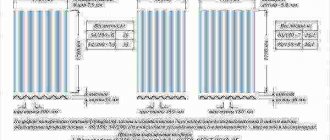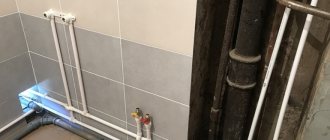Aluminum pipes are used in various fields of human activity. Most often, you have to bend a pipe when installing water supply systems, making fences, installing heated floors or heating systems. Since the price of an already bent aluminum pipe is quite high, this procedure is performed independently. There are many ways to bend pipes made of different materials. If you do not know how to bend an aluminum pipe, then in our article you will find several methods of professional bending, as well as tips for performing this procedure at home.
Production methods and technical characteristics of aluminum pipes
Rental is carried out in several ways:
- pressing of aluminum parts with a round cross-section;
- cold deformation (drawing, piercing and calibration);
- according to the principle of rolling stainless steel: welding strip or sheet.
Production of aluminum pipes
Modern technologies make it possible to produce cost-effective, high-quality products. The main feature of aluminum is its low weight. Its density (ρ = 2.7 t/m³) is more than 3 times less than ρ of carbon steel (7.85 t/m³). There are other advantages of non-ferrous metal products:
- wear resistance;
- high resistance to moisture;
- flexibility;
- plastic;
- frost resistance;
- excellent weldability;
- high electrical and thermal conductivity;
- environmental friendliness;
- resistance to rust.
One of the disadvantages of aluminum parts is low strength. But this property is compensated by the ease of deformation of the metal without changing the basic characteristics. Excellent plasticity allows you to design and build complex engineering solutions. For the production of profiles, alloys of aluminum with copper, magnesium, zinc, and other metals are often used. They are more durable and withstand variable forces well.
Aluminum pipes are not difficult to transport, loading is not difficult. Profile pipes are inexpensive and easy to install.
Aluminum products
DIY furniture made from pipes
Low table made of pipes and wood
And here is a detailed video instruction on how to make it.
Dinner table
This table made of three boards and metal pipes can be used as a dining table. A note of industrial style in the design of the room. Here you can see the manufacturing technology.
Large rack made of pipes and wood
A shelving unit for a spacious pantry or garage is an excellent solution for storing all sorts of things. It's durable and looks cool. Read the assembly instructions here.
Shelving for the room
TV, audio system, souvenirs and books - everything will fit on this homemade rack. Let's see how to do it here.
Another rack
The shape of this rack is somewhat unusual, as if it was planned for specific items. Looks cool with paintings, figurines and other contents. Here is a list of building materials and a story about production.
6. Coffee table with glass top
The legs of this table are made from bent and painted PVC pipes. As for the tabletop, it doesn’t have to be made of glass, but it certainly looks cooler. Here you will find a manufacturing guide.
Aluminum tube bed
Large bed frame with canopy made of aluminum pipes and fittings. Manufacturing instructions here.
A simpler bed made of pipes and wood
This bed looks simpler and is easier to make. You will need pipes, fittings, wooden "ribs" and a construction manual.
Canopy over the crib
Anyone can make this simple canopy from PVC pipes. It turns out a children's bed with a tulle canopy.
Simple towel rack
A few PVC pipes and fittings, and your towel rail is ready.
Cute chairs for children
You can easily make these cute chairs yourself. Frame made of PVC pipes and seat woven from threads. You can see how to braid chairs here.
Simple Camping Chairs
Small comfortable chairs for the patio or outdoor trips. Children will definitely like bright furniture. How to make such chairs, see here.
Place to play
For kids, you can organize a place to play with a PVC frame.
14. Beach style bar counter
PVC pipes painted to resemble bamboo, various attributes such as exotic masks and a thatched roof - this bar counter will be an excellent reminder of exotic hot countries and beach holidays. Read detailed manufacturing instructions here.
15. Simple and convenient drawing tablet
This lightweight drawing tablet is perfect for home practice. There is no need to attach paper to it - the album is placed on a special stand along the bottom edge of the tablet. Read how to make it here.
Areas of application
*
Aluminum requires virtually no maintenance. Due to its advantages, pipes made from this metal are widely used in manufacturing, construction and other industries:
- Production of furniture, advertising and commercial equipment.
Application of aluminum pipes
- Perilla, fences, gazebos and other structures in suburban areas and areas adjacent to private houses.
- Agriculture. Due to its high resistance to water and wear resistance, rolled aluminum metal is actively used in the installation of drainage systems. Agricultural crops also do not have a negative impact on this metal.
- Bent pipe is used in the assembly of structures with suspended facades.
- Elements of drilling rigs are constructed from aluminum parts. Thanks to high throughput, the risk of congestion in the system is reduced to zero. Rolled aluminum metal can withstand the aggressive effects of hydrocarbons for a long time.
- Laying sewer systems. Sewage and other active substances do not affect the metal in question.
- Aluminum parts are often used in ventilation systems, as they are easy to give the desired configuration and are easy to cut with a grinder.
In addition to the listed areas, aluminum pipes in products perform a decorative function: grilles, display frames, wall cladding.
Important! The aesthetically attractive appearance of metal is perfect for the manufacture of interior items.
Decor elements
Difficulty bending
*
To use aluminum parts in furniture production, decorative and other purposes, it is important to bend them correctly. Despite its ductility, the metal is unpredictable when deformed, especially in hollow products. The difficulties of bending pipes made of aluminum and alloys are due to many factors:
- Processing products to give them anti-corrosion resistance increases strength but reduces ductility.
- Pipe products produced by hot extrusion and extrusion are sensitive to bending stresses.
- Duralumins and alloys with manganese have low ductility.
Taking this into account, preparing the product for subsequent bending involves determining the grade of the alloy and the conditions for its preliminary heat treatment. If there is no certificate for the product, verification is performed in the following ways:
- studying the markings on the end sections of pipes, checking with a reference book;
- tapping a part with a hammer - a ringing sound indicates increased hardness of the material;
- soft alloys stick to the file.
If you rub duralumin products with your hand, there will be no traces left on it.
Bending aluminum while maintaining integrity
Therefore, bending of sheet aluminum of composite compositions is carried out by cutting a groove at the bending site. To do this, guides are fixed on the sheet and, using a special hand-held milling tool, a groove is cut to at least 2/3 of the depth with a sweep angle of 90 to 110 degrees, which makes it possible to bend the aluminum sheet at an angle of 90 degrees without loss of integrity.
If you have experience on how to bend a rigid aluminum sheet without breaking it, then share it in the comments section.
Source
Bending technology
The following bending technologies exist:
- Process the initial workpiece on a pipe bending machine with an elastic mandrel, for example, rubber.
- You can bend a tube with a diameter of up to 20 mm in one pass using a cold bending device.
- If it is necessary to process a more complex spatial contour or a pipe of larger diameter, the workpieces are heated. Rubber or composite drones are used.
- Reducing the area with tensile stresses. A moving roller is used for this.
Bending of parts in one plane can look like:
- ducks;
- staples;
- tap;
- Kalacha.
Tubes with two bends of 135º are a weft, if there are 3 bends (the central angle is right, the outer ones are 135º) - a bracket, at 45º - 135º - a bend, and in the form of a semicircle - a roll.
Whatever processing option for the workpiece is used, the main thing is to avoid defects during the bending process. This is achieved by choosing the right method and tool.
Kalach
Equipment use
*
Special mechanisms are used to bend pipes. They are called pipe benders and are distinguished by their operating principle. The tool can be used both in production and at home. Profile and round pipes are processed. There are such pipe benders:
- Spring-loaded. Before starting the process, the element to be bent is placed in a spring. Then apply a cold or thermal treatment method to the workpiece, at the end of which remove the spring.
Spring pipe bender
- Lever or Volnov mechanism. The workpiece is placed in a special mold that corresponds to a certain diameter. The technology does not require heating the pipe. Bending occurs under the influence of lever force.
- Crossbow. The workpiece is strengthened in a structure equipped with a bending segment. The device pushes the pipe.
Using the tool allows you to both bend and straighten aluminum parts of different configurations and diameters. At the same time, the risk of damage is minimal, almost zero. In specialized equipment the following methods can be used:
- Pushing . The aluminum part is pushed between the rollers, one of which deflects it. The result is an arched bend with a small radius.
- Rental _ A pipe with a diameter of 1 to 10 cm is rolled between bending rollers. Their size must exactly match the diameter of the workpiece. The procedure is carried out with a three-roll tool in several passes. He performs bends in the form of an arc, a ring, a spiral. Using this mechanism, you can bend both profile and round pipes.
- Pressure treatment . The process occurs using stamps that bend the parts from the outside. Another option is hydroforming. In this case, to treat the pipe, water or oil is poured into it under pressure.
- Rolling in . For this method, a rolling element of a pipe bender is used, which bends the part under pressure. The process is not accompanied by heating. In areas without pressure, the product bends in the opposite direction.
Crossbow mechanism
If there is no special device at hand, aluminum parts can be bent without a pipe bender.
Principle of operation
The operating principle of the device is based on the fact that the workpiece is rolled, resulting in bends. Before starting work, it is necessary to ground the equipment. This is especially true for structures equipped with an electric drive.
Before use, the rollers and workpiece are wiped with a dry cloth, and the installation itself is started and idles for half an hour. If any deviations occur during the running process, the equipment is stopped and appropriate adjustment work is performed. If this is provided for by the design features, then the rollers are adjusted.
At the initial stage, the profile is clamped between the shafts, after which it is rolled. The radius of curvature is adjusted by lowering and raising the operating shaft.
Processing products at home without tools
*
How to bend a pipe with your own hands when you don’t have a machine or tools, and it’s not practical to buy? You can also process a part at home or in the garage without a pipe bender using the following techniques:
- To reduce the fragility of aluminum and the load force, heat the bend area using a conventional gas burner. Plain paper will help you understand that the part is ready for deformation. It must be placed above the heated zone and wait until it starts smoking - this is a signal to start bending. This method is not suitable for anodized aluminum.
- To process the workpiece, use a template with the required bend radius. It is easily carved from wood impregnated with creosote. Place the original element on the template and secure it carefully. Take a rubber mallet and give the desired bend shape with gentle blows.
Wood template
- An aluminum tube with a small diameter (15 - 20 mm) can be processed without tools by placing a steel spring on the outer surface. Pour sand inside the workpiece and insert a metal rod. Holding the ends of the rod, crimp according to the template.
- Fill the tube with sand, secure the ends of the workpiece to two supporting planes. Use a rubber mallet to form a bend in the suspended area. The method is well suited for workpieces with a rectangular cross-section.
Thus, if it is necessary to make home repairs or independently make a decorative element from aluminum pipes, everyone will be able to bend the parts with their own hands.
Features of the pipe bender
A pipe bender is a machine that allows you to bend an aluminum tube quickly enough and in a variety of directions. You can buy it in a store or make it yourself. But first you need to understand the principle of its operation and find out what types of pipe benders exist today.
The pipe bender comes in a variety of sizes and shapes. The bending process itself occurs by rolling it between the rollers and mandrels of a pipe bender.
The variety of profiles that a pipe bender can bend is limited by the type of roller that is included in its design. In addition, this machine allows you to bend the product to a certain, pre-prepared angle.
Types of pipe bender:
- Hydraulic (with a wide range of action). Capable of bending elements of any material at any required angle.
- Manual (more common type). Suitable for bending plastic and non-ferrous metals.
- With an electric drive (increases the quality of a certain bend radius for pipes with a variety of cross-sections).
When working with a pipe bender, you must follow safety rules.
A significant disadvantage of a pipe bender is its high cost. This is especially true for models with electric drive.
Recommendations for implementation and common mistakes
Before starting the process, the part should be cleaned of dirt and dust. Do not use an abrasive brush. You should clean it carefully so as not to tear off the oxide film.
Important! After bending, the length of the tube may change. Therefore, form the desired segment after processing.
When using a gas burner to increase plasticity, the part should be bent immediately upon reaching the required degree of heating, without allowing it to cool. Do not process pipes that are bent along their entire length. This defect indicates low quality of the product. In addition, the products should not have foreign inclusions, burrs, chips, scratches, or cracks.
We use fillers - sand and water
The cavities are filled with water without impurities. Plugs are attached to the ends, then frozen in the freezer or in the cold. Bending is carried out after heating with a gas burner. The procedure cannot be used for products with galvanized coating, otherwise it will be damaged.
This option is suitable for products with a large cross-section or with a square configuration. If you need to bend it at a slight angle, it is better to use sand as a filler. After thorough heating over the entire surface, the part is bent by tapping with a mallet. Galvanized structures are bent without heating.
Important! When filling a cavity with loose filler, it must be compacted so that the internal space is filled without voids. When closing the plug, a reserve is left so that it is easier to remove at the end of the procedure.
